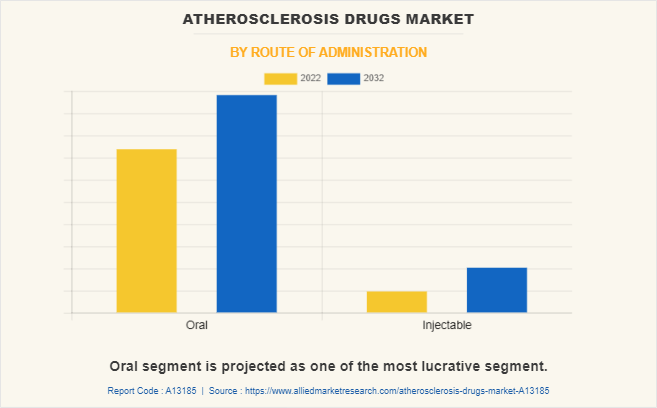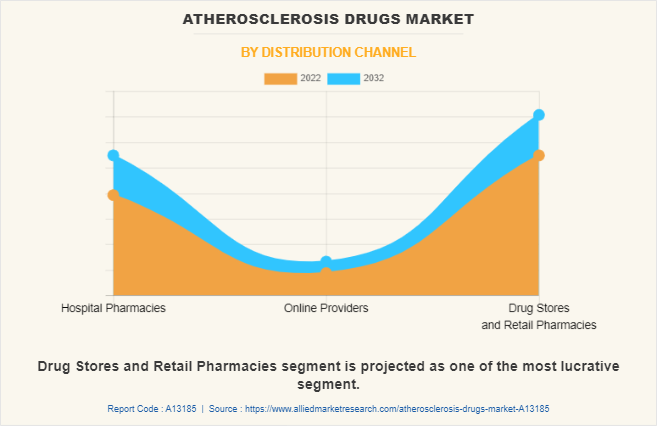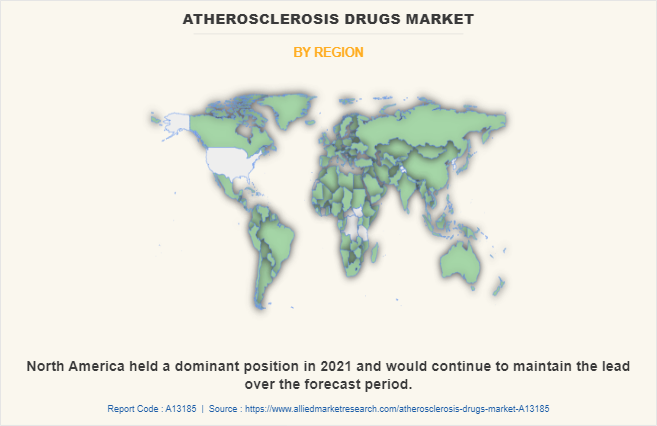Atherosclerosis Drugs Market Research, 2032
The global atherosclerosis drugs market size was valued at $20.6 billion in 2022, and is projected to reach $27.7 billion by 2032, growing at a CAGR of 3% from 2023 to 2032. Atherosclerosis is thickening or hardening of the arteries, which is caused by a buildup of plaque in the artery's inner lining. Deposits of fatty materials, cholesterol, cellular waste products, calcium, and fibrin make up plaque. As it accumulates in the arteries, the arterial walls stiffen and thicken.

Atherosclerosis is a chronic, slow-progressive condition that can develop as early as childhood. It is not clear exactly how atherosclerosis starts or what causes it. However, the inner of the artery's walls gradually thicken or accumulate plaque as a result of inflammation. The vital body organs and extremities receive less blood and oxygen as a result. Furthermore, atherosclerosis signs and symptoms may appear gradually and may be few, as the plaque in the artery gradually grows. The symptoms may vary according to the artery that is impacted. However, the signs and symptoms of a major artery blockage can be severe and resemble those of a heart attack, stroke, or blood clot. Moreover, antiplatelet, cholesterol lowering, beta-blocker, and ACE inhibitor medications can be used to treat atherosclerosis.
The pandemic had negative impact on the atherosclerosis drugs market. This was attributed to lack of workforce and high risk considering the proximity to patients while monitoring or treating them. Moreover, the pandemic had a negative impact on the ongoing clinical trials for atherosclerosis drugs, which hindered the growth of the global atherosclerosis drugs market as a result of the delayed clinical trials of products.
Market Dynamics
Growth & innovations in the pharmaceutical industry for the manufacturing of atherosclerosis drugs owing to massive pool of health-conscious consumers create potential opportunities for the expansion of the atherosclerosis drugs market size. The growth of the atherosclerosis drugs market is further expected to be driven by high potential in untapped, emerging markets, due to availability of improved healthcare infrastructure, increase in unmet healthcare needs, and rise in prevalence of cardiovascular diseases. Furthermore, the healthcare industry in emerging economies is developing at a significant rate, owing to rise in demand for enhanced healthcare services, significant investments by government to improve healthcare infrastructure, and development of the medical tourism industry in emerging countries. E-commerce (electronic commerce) has become a vital tool for small and large businesses globally, due to rise in preference of consumers for online shopping over traditional purchasing methods, which further supports the atherosclerosis drugs market growth.
The demand for atherosclerosis drugs is not only limited to developed countries but is also being witnessed in the developing countries, such as China, Brazil, and India, which fuels the growth of the market. Factors such as rise in consumption of carbohydrate-based foods, packaged foods, poor eating habits, and unhealthy lifestyle among young generation as well adults lead to increase in cholesterol level, which further drives the growth of the market. Moreover, increase in geriatric population suffering from cardiovascular disorders and rise in awareness about leading healthy lifestyle are expected to fuel the market growth in the near future.
Moreover, commercialization of novel drugs and increase in product approval of atherosclerosis drugs propel the market growth. Furthermore, the presence of a plethora of products in the pipeline and high growth potential in untapped emerging economies are anticipated to serve as attractive opportunities for market growth during the forecast period. Moreover, surge in medical tourism in developing economies and rapid implementation of technology in healthcare industry significantly propel the growth of the market. Furthermore, rise in awareness of atherosclerosis treatment is anticipated to propel market growth.
The COVID-19 pandemic negatively impacted the atherosclerosis drugs market as investments in R&D of novel atherosclerosis drugs that target atherosclerosis as well as funding by various companies engaged in the R&D sector were postponed during the pandemic. Moreover, the pandemic had a negative impact on the ongoing clinical trials for atherosclerosis, which hindered the growth of the global atherosclerosis drugs market as a result of the delayed clinical trials.
In addition, consumers focused only on highly essential products such as foods & beverages. However, with relaxation in lockdowns and decline in COVID-19 cases in 2022, companies re-started their processes to meet the demand of products. Owing to the introduction of various COVID-19 vaccinations, people can readily reach out to hospitals and pharmacies which escalated the demand for atherosclerosis drugs for the treatment of atherosclerosis. This further led to stabilization of the market.
Segmental Overview
The global atherosclerosis drugs market is segmented into drug type, route of administration, distribution channel, and region. By drug type, the market is categorized into anti-platelet & anticoagulants, cholesterol lowering medication, ACE inhibitors, and others. On the basis of route of administration, it is segregated into oral and injectable. By distribution channel, it is classified into hospital pharmacies, online providers, and drug stores & retail pharmacies. Region wise, the market is analyzed across North America, Europe, Asia-Pacific, and LAMEA.

By Drug Type:
By drug type, the anti-platelet and anticoagulant segment dominated the global market in 2022 and is expected to remain dominant throughout the forecast period, owing to increase in adoption of anti-platelet and anticoagulant medication by health-conscious customers in the market by various key players. Moreover, excessive alcohol consumption, smoking, rise in consumption of full-fat dairy products & meat cuts encourage the adoption of anti-platelet and anticoagulant medications.

By Route of Administration:
On the basis of route of administration, the oral segment dominated the global market in 2022 and is anticipated to continue this trend during the forecast period. This is attributed to increase in awareness of routine cholesterol testing and treatment as well as sedentary lifestyle that contributes to the development of many diseases, including diabetes. In addition, oral drugs offer advantages such as mucosal permeability, drug solubility, and environmental stability in the gastrointestinal tract. Therefore, they witness higher demand, which boost the growth of the atherosclerosis drugs market share.
However, injectable segment is expected to register the highest CAGR during the forecast period owing to as the injectable drugs offer several benefits to patients and healthcare providers such as high efficacy, designed to target specific areas of plaque buildup and delivering the drug directly to the affected site.

By Distribution Channel:
Depending on distribution channel, the drug stores and retail pharmacies segment held the largest atherosclerosis drugs market share in 2022 and is expected to remain dominant throughout the forecast period. This is attributed to increase in preference of toward drug stores and retail pharmacies for medicines due to availability of discounted and affordable medicines and ease of availability of atherosclerosis drugs in these pharmacies.
In addition, people visiting drug stores and retail pharmacies for purchasing atherosclerosis for medications, as it helps individuals to acquire all the information related to the drugs which further propels the segment growth. However, online providers segment is expected to register the highest CAGR during the forecast period owing to surge in usage of online pharmacy for purchasing atherosclerosis drugs and convenient to use online platform.

By Region:
Region wise, North America accounted for a major share of the atherosclerosis drugs industry in 2022 and is expected to maintain its dominance during the atherosclerosis drugs market forecast period.
Key factors that drive the growth of the atherosclerosis drugs industry is strong presence of major pharmaceutical and biopharmaceutical companies in North America. In addition, it is anticipated that rising demand for preventative healthcare will boost the market growth. Moreover, increase in government and private sector efforts to promote healthy lifestyles is anticipated to fuel market expansion in the region during the forecast period.
Furthermore, the presence of well-established healthcare infrastructure, high purchasing power, and rise in adoption rate of atherosclerosis treatment products are expected to drive the market growth. Moreover, increase in prevalence of cardiovascular disease in the region as well as rise in awareness about the disease prevention among people lead to rise in demand for atherosclerosis drugs, thereby boosting the growth of the market.
Asia-Pacific is expected to grow at the highest rate during the forecast period. attributable to presence of pharmaceutical companies in the region as well as rise in purchasing power of populated countries, such as China and India. Moreover, rise in geriatric population suffering from various cardiovascular disorders drives the growth of the market. Furthermore, Asia-Pacific exhibits high growth potential due to presence of high population base, unmet medical needs, and increase in disposable income. Moreover, rise in medical tourism and developing healthcare infrastructure make Asia-Pacific a lucrative market for atherosclerosis drugs.
Furthermore, Asia-Pacific is expected to offer profitable opportunities for key players operating in the atherosclerosis drugs market, owing to growing rise in disposable incomes as well as well-established presence of domestic companies. In addition, rise in contract manufacturing organizations within the region provides potential opportunities for new entrants in this region.
Competition Analysis
Competition analysis and profiles of the major players in the atherosclerosis drugs market such as Amgen Inc., Pfizer Inc., AstraZeneca, Bayer AG, Sanofi, Novartis AG, Viatris Inc., Johnson & Johnson, Lupin, and Bausch Health Companies Inc. are provided in this report. Major players have adopted product launch, product approval, and acquisition as key developmental strategies to improve the product portfolio of the atherosclerosis drugs market.
Recent Product Approvals in the Atherosclerosis Drugs Market
In December 2021, Novartis received the U.S. Food and Drug Administration (FDA) approval of Leqivo (inclisiran) for the treatment of adults with clinical atherosclerotic cardiovascular disease and other indications.
In February 2021, the European Commission approved an additional indication for Sanofi product Plavix (clopidogrel) to include its use in combination with aspirin in adult patients with moderate to high-risk Transient Ischemic Attack (TIA) or minor Ischemic Stroke.
In September 2021, Amgen announced that U.S. FDA approved Repatha (evolocumab) as an adjunct to diet and other low-density lipoprotein cholesterol (LDL-C)-lowering therapies for the treatment of pediatric patients aged 10 years and older with heterozygous familial hypercholesterolemia (HeFH) to reduce LDL-C.
In June 2020, AstraZeneca received the U.S. FDA approval for Brilinta (ticagrelor), which reduces the risk of a first heart attack or stroke in high-risk patients with coronary artery disease (CAD), the most common type of heart disease.
In December 2021, Bayer AG received U.S. FDA approval of Xarelto (rivaroxaban) for the treatment of venous thromboembolism (VTE) and reduction in the risk of recurrent VTE in patients from birth to less than 18 years after at least five days of initial parenteral (injected or intravenous) anticoagulant treatment.
Key Benefits For Stakeholders
- This report provides a quantitative analysis of the market segments, current trends, estimations, and dynamics of the atherosclerosis drugs market analysis from 2022 to 2032 to identify the prevailing atherosclerosis drugs market opportunity.
- The market research is offered along with information related to key drivers, restraints, and opportunities.
- Porter's five forces analysis highlights the potency of buyers and suppliers to enable stakeholders make profit-oriented business decisions and strengthen their supplier-buyer network.
- In-depth analysis of the atherosclerosis drugs market segmentation assists to determine the prevailing market opportunities.
- Major countries in each region are mapped according to their revenue contribution to the global market.
- Market player positioning facilitates benchmarking and provides a clear understanding of the present position of the market players.
- The report includes the analysis of the regional as well as global atherosclerosis drugs market trends, key players, market segments, application areas, and market growth strategies.
Atherosclerosis Drugs Market Report Highlights
| Aspects | Details |
| Market Size By 2032 | USD 27.7 billion |
| Growth Rate | CAGR of 3% |
| Forecast period | 2022 - 2032 |
| Report Pages | 250 |
| By Drug Type |
|
| By Route of Administration |
|
| By Distribution Channel |
|
| By Region |
|
| Key Market Players | Lupin, Sanofi, Amgen Inc., Viatris Inc., Bayer AG, Pfizer Inc., Bausch Health Companies Inc., AstraZeneca, Novartis AG, Johnson & Johnson |
Analyst Review
This section provides various opinions of the top-level CXOs in the atherosclerosis drugs industry. In accordance with several interviews conducted, the utilization of atherosclerosis drugs is expected to witness a significant rise owing to increase in prevalence of cardiovascular diseases and obesity in both developed and developing economies.???
Furthermore, the global atherosclerosis drugs market growth is propelled by surge in geriatric population suffering from cardiovascular disorders, increase in adoption of an unhealthy diet, and lack of physical activities due to busy lifestyle will.??
The CXOs further added that North America serves as the potential market for due to heavy expenditure by the government on healthcare, followed by Europe and Asia-Pacific. Asia-Pacific is expected to exhibit fastest market growth due to increase in diabetic population and rise in prevalence of heart attack. In addition, pharmaceutical companies have focused on expanding their presence in emerging economies, which is anticipated to drive the market growth.?
Increase in cardiovascular disorders, rise in awareness of early diagnosis and treatment of atherosclerosis are, and increase in elderly population the factors responsible for the market growth.
The leading application of atherosclerosis drugs is the treatment and prevention of cardiovascular disease, which is a major cause of morbidity and mortality worldwide.
North America is the largest regional market for atherosclerosis drugs owing to surge in prevalence of cardiovascular disease and rise in awareness about early diagnosis and treatment.
The estimated industry size of atherosclerosis drugs in 2032 is $27,711.92 million.
Top companies such as Pfizer Inc., Amgen Inc., and Viatris Inc. held high market share in 2022.
Atherosclerosis drugs aim to reduce the formation of plaque or its effects on the body by reducing cholesterol levels, decreasing inflammation, preventing blood clots, and improving blood flow.
The forcast period for atherosclerosis drugs market is 2023 to 2032
Loading Table Of Content...
Loading Research Methodology...


